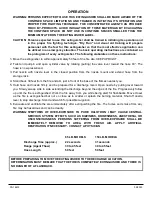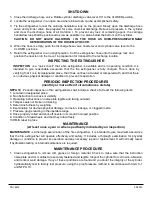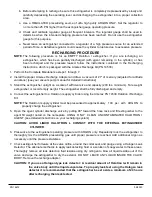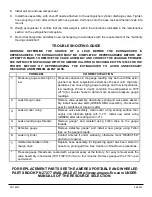
PN 16672
04/2020
b.
Before attempting to recharge be sure this extinguisher is completely depressurized by slowly and
carefully depressing the operating lever and discharging the extinguisher into a proper collection
area.
c.
Use a REGULATED pressurizing source of ultra high purity ARGON ONLY. Set the regulator to
no more than 25 PSI higher than the extinguisher gauge operating pressure.
d.
Check and calibrate regulator gauge at frequent intervals. The regulator gauge shall be used to
determine when the intended charging pressure has been reached. Do not use the extinguisher
gauge for this purpose.
e.
Never leave an extinguisher connected to a regulator of a high pressure source for an extended
period of time. A defective regulator could cause the cylinder to rupture due to excessive pressure.
RECHARGING PROCEDURE
NOTE
:
The following procedure is for an EMPTY Halotron l extinguisher. If you are recharging an
extinguisher, which has been partially discharged (with agent remaining in the cylinder) or has
been recharged and the pressure leaked, follow the instructions contained in the Recharging
Instructions, which is packaged with the Amerex Recharge Kit (PN 14538).
1.
Perform the Complete Maintenance steps 1 through 7.
2.
Install the proper Amerex Recharge Adapter and draw a vacuum of
27”
of mercury (adjusted for altitude
variations) [see your vacuum pump manual for detailed instructions].
3.
Stand the extinguisher upright on a scale of sufficient size and capacity (200 lbs. minimum). Tare weight
extinguisher or record empty weight. The extinguisher shall be fully discharged and empty.
4.
Connect the extinguisher to a Halotron l supply cylinder using the Amerex PN 14538 Halotron l Recharge
Kit.
NOTE:
The Halotron l supply cylinder must be pressurized to approximately
100 psi with ARGON to
properly charge the extinguisher.
5.
Open the agent cylinder discharge valve by pulling 90º toward the hose rack and fill extinguisher to the
agent fill weight noted on the nameplate USING ONLY CLEAN UNCONTAMINATED HALOTRON l
AGENT. [see detailed instructions on your recharging system]
CAUTION:
AVOID LIQUID HALOTRON L CONTACT WITH THE EXTERNAL EXTINGUISHER
CYLINDER.
6.
Pressurize to the extinguisher operating pressure with ARGON only. Repeatedly rock the extinguisher to
thoroughly mix the ARGON pressurizing gas until proper pressure is reached. Add additional Argon as
necessary until the pressure stabilizes.
7.
Check extinguisher for leaks at the valve orifice, around the collar seal, and gauge using a Halogen Leak
Detector. The alternate method is to apply leak detecting fluid or a solution of soapy water to these areas.
Thoroughly remove all leak detection fluid residue using dry nitrogen to blow all liquid residue out of the
valve and wipe the extinguisher to dry the exterior. DO NOT LEAVE ANY LIQUID INSIDE THE VALVE
BODY. Remove the recharge adapter.
CAUTION: If you use a Halogen type leak detector: A residual amount of Halotron l will remain in
the valve body until the liquid evaporates. To properly leak test using the Halogen leak
detector it is recommended that the extinguisher be set aside a minimum of 24 hours
after recharging, then leak tested.








